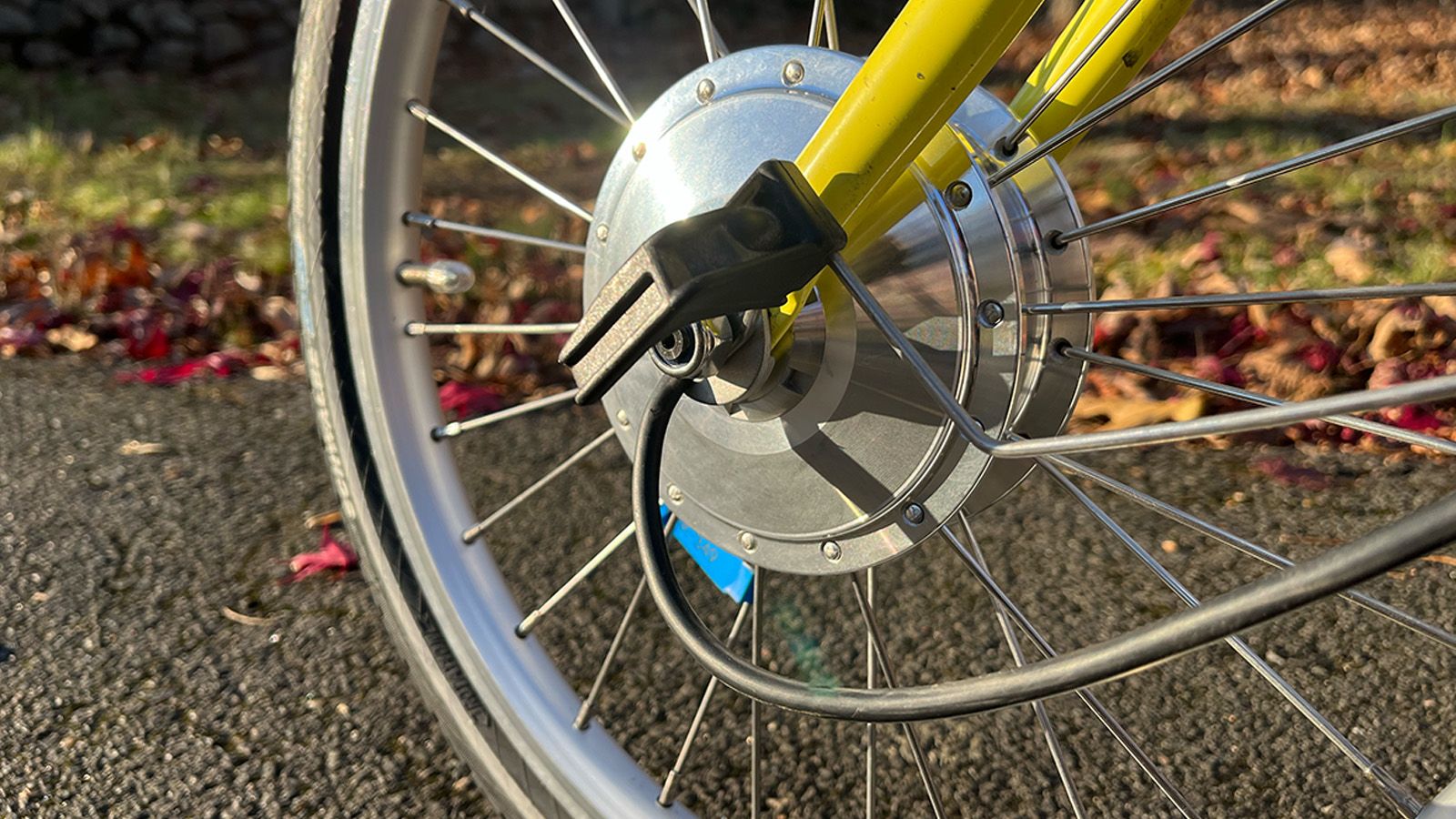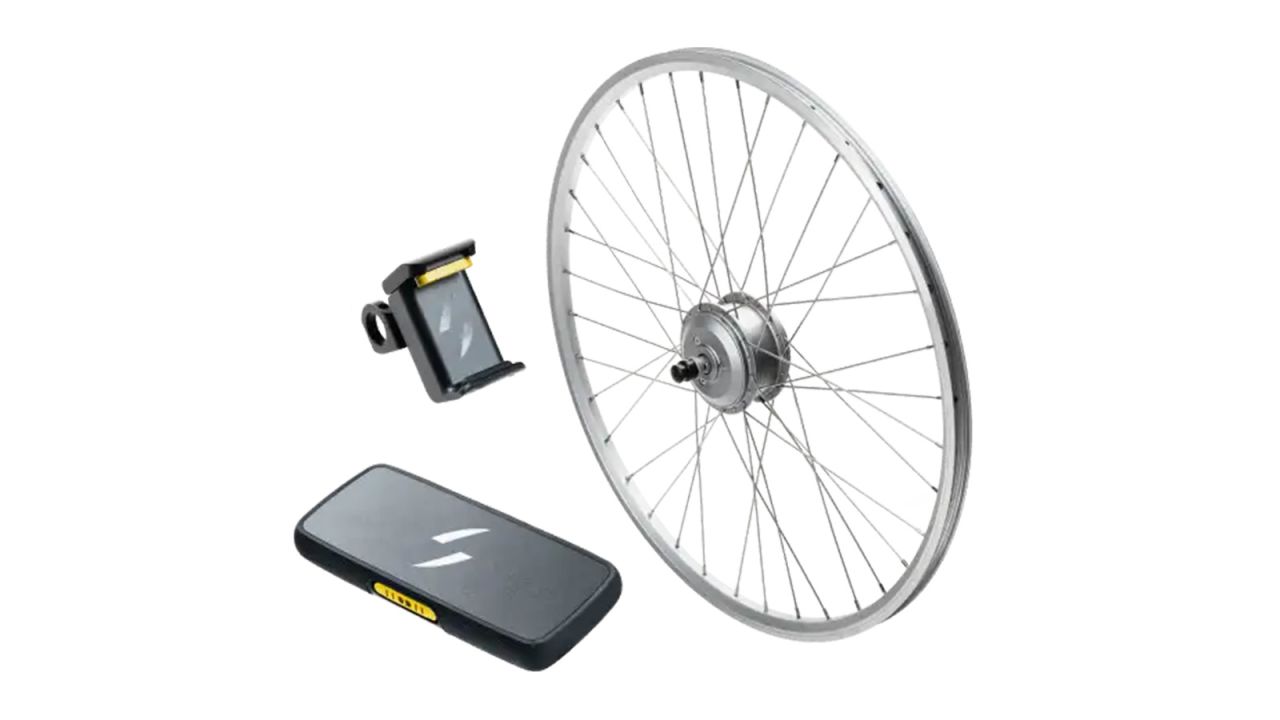If you’re considering an e-bike but you’ve been hesitating because you already have a bike you love and don’t have the storage space, or you’re uncomfortable about the cost of entry or just aren’t quite sure a motor is your speed, the Swytch conversion kit might be for you. With the swap of your front wheel and some cabling, it’s easy to install and integrates smoothly into a wide variety of bikes, and it’s just as easy to remove and swap onto another bike if you decide a motor isn’t for you or you’d just like to try it on another bike.
The kit (which includes a built wheel along with the battery mount, battery, cabling and sensors) is available for bikes of all sizes, but since the company offers a kit specifically made for folding bikes we called one in to see what it would do when added to a Brompton folder we already owned.
The Swytch Kit lets you turn your current bike into a capable e-bike. Installation is easy and performance is solid, and the small, removable battery pack makes it convenient for city commuters.
What we liked about it

The Swytch offers a way to try out the e-bike concept on a bike you already own, without jumping through a lot of hoops hunting down OEM components on your own. If you’re even slightly handy, you can easily install the kit, and while installation won’t be quite as slick as a factory unit, you can even save money overall depending on what sort of bike you’re going to use with the Swytch.
There’s a lot to like about Swytch, right out of the box. While the Swytch is a DIY kit, the motor hub comes on a nicely built wheel and the kit includes plenty of options to deal with the majority of bike setup challenges, making installation absolutely doable for any reasonably motivated person who’s changed a bicycle tire in the past and is willing to put in a little time and effort.
Getting the Swytch onto the bike?is simply a matter of mounting a tire on the wheel, swapping it for your existing front wheel, installing the battery mount on the handlebars (or replacing the carrier block, though we didn’t test that kit), picking out the right magnet-studded collar to attach at the crank arm/bottom bracket junction and running a few cables. Your mileage may vary, but mounting took us about 30 minutes (we’ve got a fair amount of bike mechanic experience, mind you), and removing it took about 15.
An upside compared to far more expensive electric folding options like the Brompton C-Line and the GoCycle, the Swytch comes with a basic handlebar-mounted control pod and computer, which makes it easy to access and keep track of power modes and monitor your speed without having to take your phone out of your pocket (or mount it to your bars). While there’s never a reason to spend all of your time looking at a cycling computer, this does provide increased utility and we wish the pricier, more capable models didn’t make us depend on our smartphone.
Once installed, the Swytch is surprisingly powerful. While it won’t set any speed records, that isn’t the point here: it is definitely comparable in performance to the Brompton C-Line electric’s motor, and capable of getting us up the 10% and 12% grades on our testing route. Motor engagement felt a little slower than on the C-Line (we felt it didn’t quite pick up our initial pedal stroke as quickly when getting started), but that could be a matter of tweaking the installation over time to fine-tune the magnet’s distance from the ring that alerts the system that the cranks are moving.
Plus, the batteries (available in two capacities) are small and light enough to easily tuck away in a bag or coat pocket, so you don’t need to leave them on a parked bike.
What we didn’t like about it

Despite the Swytch battery’s small size, we couldn’t find a great way to install the battery bracket without interfering with the Brompton’s fold or sacrificing the bike’s luggage carrying abilities entirely. We tried installing the bracket in reverse, which helped somewhat with the fold, but it exposed the bracket to potential damage, it looked a little weird, and with the larger battery mounted it interfered with out-of-the-saddle pedaling efforts unless we took care to be conscious of its position.
This isn’t an issue at all for most bikes, however. The block is great for full-size bikes, but we hope that the company comes up with a better mount for folders, or separates the block and control wiring junction, making for more installation options.
Running aftermarket cabling and control pods on a tightly designed bike like the Brompton is always going to be messier than going with a factory design, and if you are a stickler for neatness you might not like that the Swytch installation involves securing control wiring to the frame and fork with a few zip ties and adding a little collar and magnet at the bottom bracket. Zip ties are very secure, but it would have been nice to have a system that could run through the Brompton’s existing welded-on cable guides.
The kit doesn’t come with integrated lighting, and there’s no way to add it to the system. On all of the other e-bikes we’ve tested, we really appreciated the inclusion of head and taillights (often integrated with the rear brake) that don’t need to be charged separately, and it’d really improve the appeal and utility of the Swytch if these were available, even as an aftermarket add-on.
You will find two extra connection pigtails on the battery mount bracket, but these are meant for brake interrupters, which Swytch sells separately but doesn’t supply as standard. These devices, which are triggered by depressing the brake levers and which cut the motor power when the brakes are applied should you be pedaling at the time, are a common safety feature on e-bikes. We’d really like to see these come standard (though they would make installation more complex), though we can understand why they were left out in a kit meant for a bike that isn’t likely to be ridden very fast in the first place.
The retail price of a Swytch Kit starts at around $1,200 (and depending on battery size, can range up to $1,599), but it’s often discounted by the manufacturer by 50% or more. That said, the cost of fully built e-bikes is falling all the time, so it’s good to wait for the best pricing — otherwise you may not save much money versus a finished factory bike, such as the Rad Power RadRunner 2. It’s a more compelling proposition if you own something older and nice that was pricey when new — like a Brompton — since the cost of high-quality electric folders is high enough that the Swytch can represent a serious savings over a new ride.
Bottom line
If you’re looking to put it on a full-size bike that you already like, the Swytch is a pretty great DIY option. It works well, it’s pretty easy to install, it looks relatively clean on the bike and it isn’t terribly expensive. It doesn’t perform as well as the integrated systems on purpose-built bikes, but it isn’t that far off either.
On a Brompton we think the Swytch is really for budget-minded people or beginning DIYers who prefer a preconfigured kit to assembling their own setup from OEM parts. The Swytch’s functionality is comparable to Brompton’s own system (and arguably has superior controls), but the install is clunky and there’s not a great way to attach it without either sacrificing the luggage block, increasing the folded size or jury-rigging something.
But that said, if you already have a Brompton, don’t want to shell out thousands more for another and you don’t have another bike to experiment with, the Swytch may be worth the relatively low cost of entry versus the Brompton C-Line Electric.

















